Thursday September 04: Kalash valleys (Bumburet)
In the morning we drove back down the Balangura valley to the checkpoint and then west and north up the Bumburet valley. Just outside the village we saw a man building himself a house. The rock splits relatively easily into horizontal sheets and these are piled on top of one another, interspersed with wooden beams for earthquake resistance. No cement or mortar is used. We wondered whether he would have it finished before winter.
The Bumburet valley is a wider, more accessible, more prosperous valley, and is principally the one most of the tourists come to, so there are a number of small hotels (eg. our PTDC). This is definitely Kalash and traditional, but as I noted earlier, it is definitely a more sanitised version. We met a visiting group of a half a dozen people from Norfolk who were here for a ‘day trip’ from Chitral, and I’m not entirely sure they appreciated me telling them that they really needed to visit one of the other valleys to get a true impression of how hard Kalash life is. The Kalash are not a museum, they are real people living a bloody hard life.
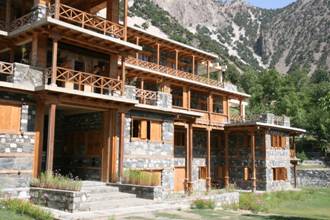 But good
luck to the Kalash, why shouldn’t they get some of the improvements and
benefits of modern life such as electricity and schooling? One of the issues
though is that they do not get as much out of the tourism as they might because
all the hotels are Muslim owned.
But good
luck to the Kalash, why shouldn’t they get some of the improvements and
benefits of modern life such as electricity and schooling? One of the issues
though is that they do not get as much out of the tourism as they might because
all the hotels are Muslim owned.
Despite my comment above, Bumburet does in fact have a superb museum of Kalash life which was built by the Greeks in 2005. There are lots of exhibits of Kalash artefacts, their history, their beliefs and their way of life, together with reconstructed versions of their houses and historically important items such as carvings, pots and implements. The reconstructed houses do give a decent idea of how they live, but as we noted, without the soot, the dirt, and the smells (a standard Kalash house has a central fire and a hole in the roof to let the smoke out, consequently soot and a smoky smell accumulates in the house). It really is an excellent museum.
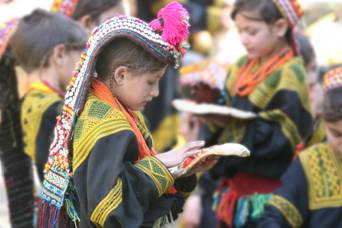
The top story of the school houses a Kalash school, apparently there are 70 children and four teachers, and it was lunchtime when we were there. For lunch the children all seemed to have a chapatti with a sort of red-coloured paste on it; modesty determined that we should not ask what the paste was. Needless to say all the girls (and female teachers) were colourfully attired, whilst the boys had their own uniform which was different to what you normally see Pakistani children wearing.
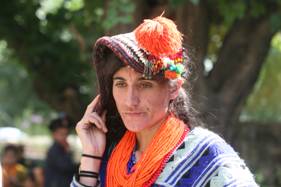
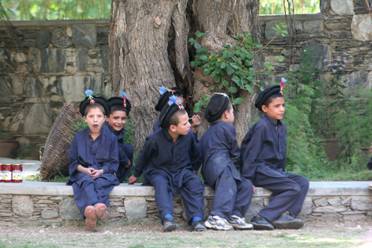
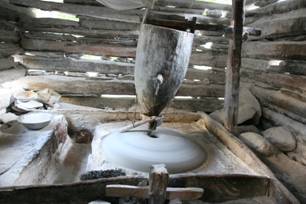
Throughout our trip we had seen water driven flour mills, but here we finally got to see one working. Wheat grain is placed in the hopper and a stick knocks against the rotating wheel and this gradually jiggles the grain into the hole in the rotating grinding stone where it then spreads under the stone and is ground. There you are, automatic, and it works.
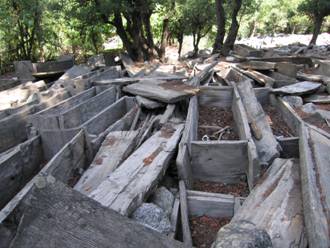 It may seem
ghoulish, but the other thing well worth seeing in Bumburet is the old Kalash
cemetery. The Kalash used to place the dead in wooden coffins and in a
designated area, but open to the elements – a bit like the ‘sky burials’ of the
Zoroastrians of Iran – where the bodies were then gradually consumed by animals
and birds. So, the old cemetery is a jumble of old wooden coffins with bones
and skeletons inside. You wonder if you should take photographs, but no one
seems to mind. Fascinating. Burial is not done that way any more of course.
It may seem
ghoulish, but the other thing well worth seeing in Bumburet is the old Kalash
cemetery. The Kalash used to place the dead in wooden coffins and in a
designated area, but open to the elements – a bit like the ‘sky burials’ of the
Zoroastrians of Iran – where the bodies were then gradually consumed by animals
and birds. So, the old cemetery is a jumble of old wooden coffins with bones
and skeletons inside. You wonder if you should take photographs, but no one
seems to mind. Fascinating. Burial is not done that way any more of course.